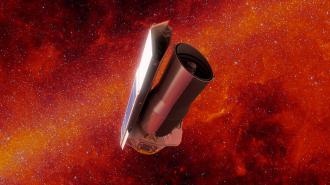A space startup has an audacious plan to revive NASA’s retired Spitzer Space Telescope — and it involves sending a robot mechanic on a 186 million mile journey.
The retiree: NASA launched the Spitzer Space Telescope — the last of four “Great Observatories” — in 2003, putting it into an “Earth-trailing orbit” that meant the telescope would slowly drift away from Earth while following the planet around the sun.
Spitzer’s mission was expected to last less than five years, but it remained operational until 2020, when NASA put it into “safe mode” to free up resources for the James Webb Space Telescope.
“Spitzer has taught us about entirely new aspects of the cosmos and taken us many steps further in understanding how the universe works, addressing questions about our origins, and whether or not are we alone,” said Thomas Zurbuchen, then-associate administrator of NASA’s Science Mission Directorate, at the time.
“Our best estimate is that it will still be in an operating condition.”
Giovanni Fazio
The resurrection: The Spitzer Space Telescope could be coming out of retirement: the Space Force has given Washington, DC-based startup Rhea Space Activity (RSA) $250,000 to develop the “Spitzer Resurrector Mission.”
RSA’s plan is to launch a small spacecraft, the Spitzer Resurrector, by 2026. It’ll then spend about three years traveling the 186 million miles to Spitzer, which is now trailing the Earth by so much that it is on the other side of the sun, making direct communication with Earth impossible.
Once the spacecraft reaches its destination, it will assess Spitzer’s health from a distance of about 30 to 60 miles.
“The solar cells may be degraded, and there may be meteorite impacts,” Giovanni Fazio, co-investigator of the mission, told Ars Technica. “So it’s an uncertainty what condition the telescope is in. But our best estimate is that it will still be in an operating condition.”
“The ISAM implications of resurrecting Spitzer are jaw dropping.”
Shawn Usman
If Spitzer appears functional, RSA’s spacecraft will restart the telescope using in-space servicing, assembly, and manufacturing (ISAM) techniques developed by the Space Force and Air Force.
After confirming that the Spitzer Space Telescope is operating as designed, the Resurrector will stick around to serve as a high-rate data relay between Earth and the telescope, which will likely be tasked with detecting and classifying potentially hazardous near-Earth objects.
The big picture: The Spitzer rescue mission is far from a certainty — while the Space Force funding will support development, RSA expects the mission itself will cost $350 million.
If the Space Force decides the cost is worthwhile, not only will the US get back one of its Great Observatories, it’ll also learn if its ISAM techniques work as hoped, meaning they could then be used to repair or construct other spacecraft in space.
“The ISAM implications of resurrecting Spitzer are jaw dropping,” said Shawn Usman, RSA’s founder and CEO. “This would be the most complex robotic mission ever performed by humanity.”
We’d love to hear from you! If you have a comment about this article or if you have a tip for a future Freethink story, please email us at [email protected].






